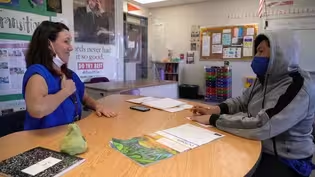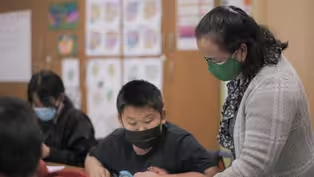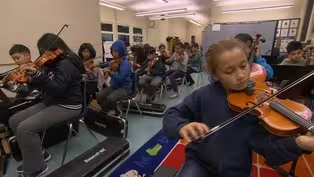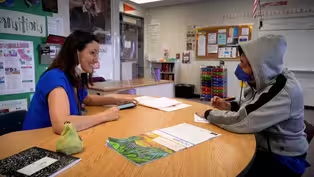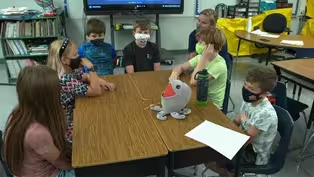Inside California Education
A Return to School
Season 4 Episode 9 | 26m 46sVideo has Closed Captions
Students return to school after remote learning.
Students return to school after a year of remote learning at a summer program in Napa. Go inside a Hmong dual language immersion program in Fresno, one of only five such programs in the nation. Meet a teacher whose personal journey inspires her work in a Deaf and Hard of Hearing Program. Explore an after-school music immersion program in San Gabriel, which has transformed the school’s culture.
Problems playing video? | Closed Captioning Feedback
Problems playing video? | Closed Captioning Feedback
Inside California Education is a local public television program presented by KVIE
Funding for the Inside California Education series is made possible by the California Lottery, SchoolsFirst Federal Credit Union, Stuart Foundation, ScholarShare 529, and Foundation for the Los Angeles Community Colleges.
Inside California Education
A Return to School
Season 4 Episode 9 | 26m 46sVideo has Closed Captions
Students return to school after a year of remote learning at a summer program in Napa. Go inside a Hmong dual language immersion program in Fresno, one of only five such programs in the nation. Meet a teacher whose personal journey inspires her work in a Deaf and Hard of Hearing Program. Explore an after-school music immersion program in San Gabriel, which has transformed the school’s culture.
Problems playing video? | Closed Captioning Feedback
How to Watch Inside California Education
Inside California Education is available to stream on pbs.org and the free PBS App, available on iPhone, Apple TV, Android TV, Android smartphones, Amazon Fire TV, Amazon Fire Tablet, Roku, Samsung Smart TV, and Vizio.
Providing Support for PBS.org
Learn Moreabout PBS online sponsorshipAnnc: Coming up on Inside California Education: (Kids chanting) Annc: Kids are finally returning to school after many months of remote learning.
Discover how students in Napa are making up for lost learning at a summer program that'’s both fun and academic.
Matt Manning: Students are learning.
Students are engaged, um, in academic and enrichment activities.
Meet a teacher in the Deaf and Hard of Hearing program in Solano County, whose personal journey inspires her to advocate for better education for her students.
(Students speaking Hmong) Annc: Go inside a program in Fresno that teaches students in both English and Hmong.
It'’s one of only five such programs in the nation, celebrating the Hmong language and culture with students of all backgrounds.
Rhianna: It makes me feel very happy and surprised that I'm learning it very fast.
Annc: And explore an after-school music immersion program in San Gabriel, which has helped transform the school'’s culture and reputation.
Cheryl Labanaro Wilson: They see how proud our students are, and it has really made a change, um, in how the community and people perceive our school.
Annc: It'’s all next - on Inside California Education!
Funding for Inside California Education is made possible by: At the California Lottery, we'’re focused on our mission to provide supplemental, essential funds to public schools - kinder through college.
Helping to keep teachers on staff, or pay for new school computers, band equipment, and other instructional materials and services.
Since 1985, we have raised more than 37 billion dollars.
And more than 95% of our sales go back to the community.
Music to all of our ears.
California Lottery - helping schools and communities across California.
The Stuart Foundation - Improving life outcomes for young people through education.
ScholarShare 529 - California'’s state-sponsored, tax-advantaged 529 college savings plan, designed to help pay for the cost of higher education.
Additional funding for Inside California Education is made possible by these organizations supporting public education.
♪♪ ♪♪ (Kids chanting and cheering) Eduardo: This is, uh, what kids need, especially in this summer.
This has been, you know, the closest thing to normal for them, that they've experienced, uh, in a year.
(Cheering) Michael: They spent a full school year away from each other, learning and studying behind computer screens.
Now, these students in the Napa Valley Unified School District are thrilled to be together, once again.
This summer school program is helping these 2,000 students transition back to in-person education.
The program combines academic learning in the morning with summer camp activities in the afternoon.
Matt: Our goal is twofold.
We... we... we want to see our students gaining some of the academic skills that they may have missed out on, um, given the pandemic.
And we want our students and families to feel much more comfortable about reentering school in-person.
We'’ve had families who've had a little bit of fear and anxiety around that in the past and have opted to keep their children home.
So, we wanted to provide a way that students and families could really come back and feel comfortable with being in-person in the fall.
Class: Strong.
Kirsten: Next row, go.
Michael: Educators across California recognize the negative impacts for students who fell behind during a year of online schooling - also known as "learning loss."
This summer school program was designed to reverse some of that learning loss by reviewing math and literacy skills.
Kirsten: We're spending two weeks on, um, just a review of second grade skills.
So, skills they should have learned this past year, but maybe haven't solidified quite yet.
So, it's really important to have this time to give those kids a little more opportunity for review, or, even, I'’m finding some kids didn't actually learn the skills.
So, let's take a look up here at our three digraphs that we learned today.
I'm able to give immediate feedback in person.
When you're on Zoom, it's really hard because kids may be holding their work up and it's hard to see.
I'm watching them do their writing.
I can see quickly where they've made mistakes and I can intervene and redirect and give them feedback.
So, I think, um, to have that opportunity for a little more feedback before the school year starts is going to be really valuable for them.
♪♪ Michael: Of course, the day isn'’t all work.
The students get time for socializing and exercise on the playground.
And after lunch, Camp EDMO begins.
All: Uh-huh!
Alright!
One more time!
EDMO is a nonprofit afterschool and summer school provider that paired with the district to provide hands-on activities.
For students like Gianna, it'’s a big motivating factor for attending summer school.
(Kids cheering) Gianna: We work a bit, but not, like, too much, because, like, it's EDMO summer school.
They wanted to make it a bit fun.
Uh, we do art.
Sometimes we build towers.
Uh, we can build houses out of paper.
We do a lot of art, which is my favorite part about school.
Eduardo: Kids are doing hands-on STEAM activities, things like building cities, um, Minecraft, uh, coding, uh, scratch coding, um, they're doing- so, all kinds of, like, hands-on learning.
Uh, and at the same time, we're working on our social, emotional learning skill building through the curriculum.
Ideally, when kids leave EDMO, they're continuing to learn about whatever it was they did at camp at home.
Uh, and they're being just a... a... a more authentic version of themselves, too.
This was the first time in several years that Napa was able to offer this type of summer school.
That'’s because they received extra funding from the federal CARES Act during the pandemic.
Matt: We would love to have ongoing funding to be able to do this for our students every year.
This has been an incredibly successful program, students are learning.
Students are engaged, uh, in academic and enrichment activities.
So, we would love nothing more than to be able to continue to offer programs of this caliber to our students.
Eduardo: We know that, um, a typical child, uh, from a middle-income family gets 6,000 hours more of enrichment than a low-income child, uh, by the time they're in sixth grade.
So.
that's a huge disparity, right?
Some kids get nothing, and other kids get everything.
And so, the funding that's coming through now is allowing everyone to get everything.
Kirsten: I'm happy to be here.
I'm happy to be with kids again.
Uh, I feel...
I feel like it's, it's great for everybody, for the adults, for the kids.
Um, getting back into that routine.
(Kids yelling) ♪♪ Annc: Studies show students lost approximately 2 and half months of learning in English language and math during the 2020-21 school year, due to remote learning.
School districts responded, with 88% offering summer school in the summer of 2021.
Summer school is most effective when it'’s free, voluntary, and includes meals.
It'’s fun, engaging, with hands-on learning activities.
And provides academic learning for three hours a day, for at least five weeks.
♪♪ Katherine Reyes: Hello!
I'm Katherine Reyes.
I'm a deaf and hard of hearing teacher and I work at the high school.
It'’s called Rodriguez High School.
We have this deaf and hard of hearing classroom where we provide access to language, successfully, and it transitions them better for the... the general mainstream courses.
I include the deaf culture, my own personal experience, my life lessons and so, I try to build their confidence, their pride in being a deaf person.
And how I can do that is by telling them my life experiences.
And maybe they can see the connection.
Kristen: Katherine Reyes lost her hearing at the age of 4, after contracting bacterial meningitis.
She got a cochlear implant in 3rd grade, but school continued to be a challenge.
Katherine Reyes: I did not have an interpreter, uh, because I was supposed to be using my listening skills from the cochlear implant to communicate with my teachers and my classmates.
Unfortunately, it was not a good experience for me.
Kristen: It wasn'’t until 9th grade when Katherine finally had access to an interpreter.
Katherine Reyes: That interpreter came into my math class, and when she came in, it completely changed my world.
Whatever classwork that we were doing, that interpreter would tutor me on... on those signs in the language needed to understand that class, and it really helped me remember that... that if you have access, it worked, then I...
I was actually learning something.
Kristen: Katherine went on to graduate from UC Berkeley.
She'’s now a leader in the Deaf and Hard of Hearing Program at the Solano County Office of Education.
In 2020, she earned their Teacher of the Year award.
Katherine Reyes: My goal for this classroom is to get you to college, is to develop that academic language so that you can access the knowledge.
You just have to show up to class and do your best.
We provide the interpreters; we provide the access, because if you have access to language, then that means you're going to acquire the education.
You'll be successful, just like the hearing students out there.
Kristen: She says having access to language means learning American Sign Language at an early age.
Katherine Reyes: We see students who are 9, 10, even up to 16 years old, who cannot read.
They can't do simple addition or subtraction because they didn't get access at an early age.
Many of my students become college students because they have language.
Language is what's important.
Kristen: Katherine says she still faces barriers every single day, but she'’s motivated to improve education for students who are deaf or hard of hearing.
Katherine Reyes: I think a beautiful goal for the future of deaf education, specifically with our program, but really any program across the United States, is to have a program that focuses on, specifically, deaf needs.
My hope is that we can develop our program to focus and hire teachers who are trained to work with the deaf students from birth all the way up to young adults, so that we can identify what works, specifically, for deaf children and their needs.
Annc: Still ahead on Inside California Education: A pre-pandemic look at an award-winning music immersion program, where all students experience a variety of instruments and musical styles after school.
Cheryl Labanaro Wilson: Watching the students glow and just resonate with the music as they perform.
It's just...
It's wonderful to see.
Annc: But first, discover how a Central Valley city with one of America'’s largest Hmong populations developed a Hmong dual language program from the ground up.
(Students speaking Hmong) Jenny Yang: I love music.
Music is a hobby of mine.
(All singing) It also, uh, brings me joy because I get to share what I love with my students.
Michael: Jenny Yang is a 3rd grade teacher at Vang Pao Elementary School in Fresno.
She'’s teaching these students in both English and Hmong, as part of a dual language immersion program.
Today'’s lesson is inspired by her own personal journey.
Jenny Yang: When I was in 3rd grade, I was classified as an English Language Learner.
So, what really helped me during that time was my own classroom teacher bringing in musical instruments and just incorporating songs.
Michael: Fresno is home to the second largest Hmong population in the United States.
Tens of thousands of refugees from Southeast Asia settled in Fresno in the decades following the Vietnam War.
Yua Lee was one of them.
She'’s the Principal at Vang Pao Elementary and was only 8 years old when her family settled in Fresno.
Yua Lee: We were transplanted into a new community, into a new place where we didn't speak the language.
There was no Hmong, um, instructional aide, or no Hmong teacher to support us.
So, we are very fortunate to be the first school in Fresno Unified that has started this Hmong 50-50 dual language immersion program.
Michael: Education at the school is offered in Hmong 50% of the time, and English 50% of the time.
The program extends from Pre-K through 4th grade.
English learner students are mixed with English proficient students - with the goal of promoting bilingualism, biliteracy and cultural appreciation.
Rihanna: The sentences that I like to say in Hmong is <speaking Hmong> and that means: "“I like to play with my friends.
"” It makes me feel very happy and surprised that I'm learning it very fast.
Sandra Toscano: Our classes are just a very culture-rich experience.
You'll find examples, um, from the Hmong culture and how there's a balance between Hmong culture and the American culture.
Michael: The Fresno Unified School District's Hmong Dual Language Immersion program is one of only five in the country, and one of two in California.
Yua Lee: I'm just really excited that we were one of the- we were the first school to start the Hmong DLI program.
We all love the program.
Michael: Situated in Southeast Fresno, Vang Pao Elementary School is largely made up of Spanish-speaking students and Southeast Asian students, who are predominately Hmong.
Yua Lee: 40% or more of our students are what we call "English language learners."
So, that means they come to school either speaking Spanish, Hmong, or another language in the house.
Sandra Toscano: Through the instruction, they're learning about the culture, um, the region, uh, where the language comes from, and they're learning core content, through the Hmong language.
Jenny Yang: So, being a Hmong girl from a Hmong family, I really understand the struggles, whether they are... are Hmong descendants or Hispanic descendants, a lot of them, they are starting, um, at the same playing field because a lot of them, or majority of them, are not coming to the classroom with the Hmong language skills.
Michael: The Hmong language can be especially challenging for non-native speakers because tones can change the meaning of words.
(Student speaking Hmong) Yua Lee: Well, the Hmong language is actually kind of very complicated.
Uh, it's really based on tonal.
It's also monosyllabic.
Jenny Yang: What is different about the Hmong language is that we do have eight tonal markers, which- it is also a very big challenge to someone learning Hmong for the very first time.
Michael: Christopher is a 4th grader from a Hmong family and has been in the dual language program since kindergarten.
Thai Her: If you can't speak your supposed native tongue, I think you lose a part of yourself.
I mean, my Christopher knows how to read in Hmong, knows how to write in Hmong.
He loves it because he gets to learn about, you know, what it is to be Hmong.
What is Hmong?
I mean, the history, uh, the culture, the heritage, the food.
Christopher: I love learning Hmong for some reason, because learning Hmong, it's like my... my culture and I love my culture, and so, I wanted to speak that way.
Sandra Toscano: Research shows that a student's cognitive development is much higher when they are proficient in two languages.
So, it not only benefits them, um, throughout their, you know, K-12 experience, but they're able to take those skills into the real world.
Michael: That is why the Fresno Unified School District is striving to expand their Hmong DLI program to be available for all students, Pre-K through 12th grade.
Yua Lee: We're going to continue to work hard and make the program better each and every single day, and to continue to grow the Hmong program and support our students to become bilingual, biliterate and bicultural, so that when they leave us, they will be ready for the world.
Michael: The district hopes their graduates will use their Hmong language skills in the Fresno community, working in fields like healthcare, public safety, and education.
It also connects students more deeply to their cultural roots.
Jenny Yang: "People need the ability to read and write in their first language, no matter how many other languages they know, they need to read and write in the language of the heart, the language of the home, not just the language of the school.
"” This quote really inspired me when I was in the Teacher Education Program.
I also hope that this quote also encourages you, as the viewer, or parents at home as well.
Thai Her: I'm glad we have the program.
I'm glad my... my son has been in it since the pilot program.
Um, I'm glad that it's getting, you know, bigger and better.
And, as a parent, watching my son learn and grow, I think it's a beautiful thing.
♪♪ Annc: The Global California 2030 Initiative was launched in recent years by the California Department of Education.
Its goal is to quadruple the number of dual language immersion programs to 1,600 programs by 2030.
Half of all kindergarten through 12th grade students in California would participate in programs that would lead to proficiency in two or more languages.
By 2040, the state wants three out of four students to be bilingual, qualifying them for a State Seal of Biliteracy on their high school diploma.
Teacher: Two... one, two, ready, go.
Lyra: In second grade, I began playing violin, recorder, and drums.
Jim: Lyra is a third grader at Roosevelt Elementary School in San Gabriel, where she'’s learned how to play multiple instruments.
Lyra: I played recorder for a second year and I'm also doing, um, violin again, and now I'm doing a new one called piano.
Jim: Every student at Roosevelt has similar access to music, thanks to a program launched in 2015 called the Music Immersion Experience.
It takes place after school, and every student is automatically enrolled.
You can opt-out, but few do.
Students get between 30 minutes to up to two hours of music each day, depending on their age and interest.
Christie Esparza: One of the biggest things that we were discussing was the length of the day the kids would be at school.
Would that even be something that the kids can do?
Do they have the stamina to be at school from 8 '’til 5?
You know, um, I don'’t, but it turns out, they do.
Jim: This after-school Music Immersion Program has transformed the school culture at Roosevelt, changing it from an underperforming school to one that'’s won state and national recognition.
Cheryl Labanaro Wilson: The community has not always seen Roosevelt as a positive school.
Um, we are a low-income school, uh, we're a Title 1, or Provision 2 school.
So, they always see us as a poorer school.
Because of the music program, our students are now getting out in the community.
They're seeing us perform.
They're seeing how confident our students are.
They see how proud our students are, and it has really made a change, um, in how the community and people perceive our school.
Jim Symonds: At first, people were a little hesitant and it seemed a little out of the box, but now the whole district has embraced the program.
Jim: The biggest hurdle was cost.
The district used local control funding dollars to hire 18 music teachers and purchase instruments.
It was controversial.
But now, several years into the program, that effort appears to be paying off.
The school has seen a 75% drop in discipline incidents, an increase of 15 points in Math scores, and an increase of 27 points in English scores.
Christie Esparza: We'’re seeing a rise in their performances in math and reading and behavior.
They're excited to be there.
Dr. Gary Scott: There's a climate at... at the school that's just profoundly changed, a much better respect amongst the students, a much better sense amongst the... the teaching staff here.
It'’s had a global effect on everything.
Jim: The program aims to expose students to different types of instruments, as well as a variety of musical styles, rhythms and songs.
Sierra: I'’ve heard a lot of different, like, songs on the violin that just sound so beautiful.
Lyra: I like the best is when we get to play because the sound is so beautiful.
Anytime I hear it from different people and myself, I just like it.
Sean: My elective is the best part of the music period.
I go to rock band and, uh, I just love to rock out there.
I like to rock out on the guitar.
And it's just, it's my favorite kind of music.
Yasmin Maestro: It'’s amazing the opportunities that they've been able to have through the music program.
I, as a parent, necessarily, may not have been able to give them these opportunities, and the exposure that they have to all the different kinds of instruments and lessons and theory that they present during the classes.
It's phenomenal.
♪♪ Paulina: Good.
♪♪ Jim: Paulina Nunez Miranda teaches Folklorico.
The traditional Mexican dance incorporates music, Spanish language, and history.
Paulina Nunez Miranda: I always tell the students, um, I treat you all like a professional dance group, not a children's dance group.
Because Folklorico is a Mexican tradition, we have a lot of cultures that come in and they ask, "Can I be part of it?"
And yes, they can, because it's an open thing.
So, we have a lot of cultures come in and they learn about the traditions of one specific culture, and they feel involved.
Jim: Educators say this school'’s musical experiment is a success.
And it'’s one they hope to someday replicate in other schools throughout the district.
Christie Esparza: It's surprising what the kids can do.
I'm amazed whenever I get a chance to watch them, what they have been able to do.
I can walk into a classroom, unexpectedly, to do something and I'm watching them read music notes.
I'm watching them play the violins and sound phenomenal.
I love it.
Samantha Theisen: I want students to have more meaning in their life.
I want them to have an outlet.
I want them to understand that music is part of what makes us human.
It's not, um, just what talented people do.
Dr. Gary Scott: It's really exciting because the theory is playing out now and we can look at it and say, gosh, it works.
♪♪ Annc: That'’s it for this edition of Inside California Education.
If you'’d like more information about the program, log on to our website: insidecaled.org.
We have videos from all of our shows, and you can connect with us on social media.
Thanks for joining us.
We'’ll see you next time on Inside California Education.
♪♪ ♪♪ Funding for Inside California Education is made possible by: At the California Lottery, we'’re focused on our mission to provide supplemental, essential funds to public schools - kinder through college.
Helping to keep teachers on staff, or pay for new school computers, band equipment, and other instructional materials and services.
Since 1985, we have raised more than 37 billion dollars.
And more than 95% of our sales go back to the community.
Music to all of our ears.
California Lottery - helping schools and communities across California.
The Stuart Foundation: Improving life outcomes for young people through education.
ScholarShare 529: California'’s state-sponsored, tax-advantaged 529 college savings plan, designed to help pay for the cost of higher education.
Additional funding for Inside California Education is made possible by these organizations supporting public education.
♪♪
Day in the Life – Deaf and Hard of Hearing Teacher
Video has Closed Captions
Clip: S4 Ep9 | 3m 59s | Meet a teacher in a Deaf and Hard of Hearing Program in Solano County. (3m 59s)
Video has Closed Captions
Clip: S4 Ep9 | 6m 51s | Go inside a Hmong dual language immersion program in Fresno. (6m 51s)
Video has Closed Captions
Clip: S4 Ep9 | 5m 38s | Explore an after-school music immersion program in San Gabriel. (5m 38s)
Preview: S4 Ep9 | 30s | Visit a Hmong dual- language program in Fresno. (30s)
Video has Closed Captions
Clip: S4 Ep9 | 5m 24s | Students return to school after a year of remote learning. (5m 24s)
Providing Support for PBS.org
Learn Moreabout PBS online sponsorship
- News and Public Affairs

Top journalists deliver compelling original analysis of the hour's headlines.

- News and Public Affairs

FRONTLINE is investigative journalism that questions, explains and changes our world.












Support for PBS provided by:
Inside California Education is a local public television program presented by KVIE
Funding for the Inside California Education series is made possible by the California Lottery, SchoolsFirst Federal Credit Union, Stuart Foundation, ScholarShare 529, and Foundation for the Los Angeles Community Colleges.
